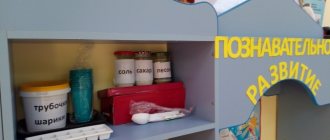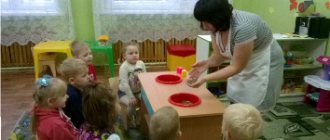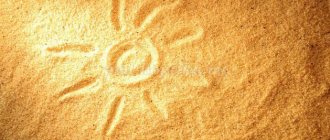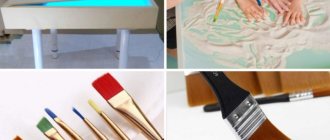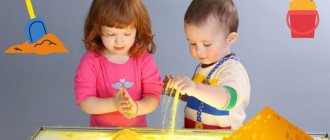Experiments with sand
Target:
1. Help children better understand the inanimate world around them;
2. Create favorable conditions for sensory perception, improving such vital mental processes as sensations, which are the first steps in understanding the world around us.
3. Through games and experiments, teach children to determine the physical properties of sand.
4. Teach children to make independent conclusions based on the results of the examination.
5. Nurture the moral and spiritual qualities of a child during his communication with nature.
Experiences and experiments with sand:
No. 1 “Where does sand come from”
Material: stones, sheets of white paper, magnifying glass.
Progress of the experiment:
Take 2 stones and knock them against each other, rub them over a sheet of paper.
- How do you think it's pouring in?
- Take your magnifying glasses and look at this.
- How did we get sand?
- How does sand appear in nature?
Conclusion: Wind and water destroy stones, as a result of which sand appears.
No. 2 “What is sand made of”
Materials: cups of sand, sheets of white paper, magnifying glasses.
Progress of the experiment:
Pour sand onto a piece of paper and examine it with a magnifying glass.
- What is sand made of? (grains – grains of sand)
- What do grains of sand look like?
- Are grains of sand similar to each other?
To get a large pile of sand you need a lot of sand.
Conclusion: Sand consists of small grains of sand that do not stick to each other.
No. 3 “Does sand fall easily?”
Material: trays with sand.
Progress of the experiment:
Offer to take a handful of sand into your fist and release it in a small stream.
- Does it crumble easily?
Conclusion: dry sand easily crumbles and crumbles into grains of sand.
No. 4 “Why is it inconvenient to play with sand in strong winds”
Material: “sandbox” - a jar filled with a thin layer of sand.
Progress of the experiment:
Examination of the prepared “sandbox”. We create a “hurricane” - we sharply squeeze the can with force.
- What's happening and why?
Conclusion: The grains of sand are small, light, do not stick to each other, they cannot hold on to each other or to the ground with a strong stream of air.
No. 5 “Where did the water disappear?”
Material: cups with sand and water.
Progress of the experiment:
Pour water into a glass with sand. Let's touch the sand.
- What has he become?
- Where did the water go?
Conclusion: water is quickly absorbed into the sand.
No. 6 “Sculpting from sand”
Material: trays with wet sand.
Progress of the experiment:
Let's try to make balls and sausages from wet sand. Leave until dry
- What happens to sand crafts after drying?
Conclusion: You can sculpt from wet sand, but after drying it crumbles.
No. 7 “Wet sand takes any desired shape”
Material: tray with wet sand, various molds.
Progress of the experiment:
Pour wet sand into molds and make figures.
- What kind of figures did you get?
- What kind of sand were you able to make the figures from?
Conclusion: Wet sand takes any shape.
No. 8 “Traces and prints remain on wet sand”
Material: trays with wet and dry sand.
Progress of the experiment:
Offer to leave handprints on dry sand.
- Are the prints clearly visible?
The teacher wets the sand, mixes it, levels it, and suggests leaving handprints on the wet sand.
- Is it working now? (Look, every finger is visible)
Conclusion: There are traces and imprints on wet sand, but not on dry sand.
Final event: “Sand Country” (drawing with dry sand)
Materials: dry sand, sheets of paper with drawn pictures, glue sticks.
Procedure: Suggest using a glue pencil to outline the entire drawing, and then pour dry sand onto the glue.
- Shake off the excess sand and see what happened.
Conclusion: You can paint with dry sand.
card index of experiments and experiments with sand card index (senior group) on the topic
No. 1. Sand cone.
Purpose: To show that layers of sand and individual grains of sand move relative to each other.
Equipment:
1. Dry sand.
2. A tray on which you can pour sand.
Experience: Take handfuls of dry sand and slowly pour them out in a stream so that the sand falls in the same place. Gradually, a cone forms at the site of the fall, growing in height and occupying an increasingly larger area at the base. If you pour sand for a long time, then in one place, then in another, “floating” will occur - the movement of sand, similar to a current. Why is this happening? Let's take a closer look at the sand. What does it consist of? From individual small grains of sand. Are they attached to each other? No! Therefore, they can move relative to each other.
Conclusion: Layers of sand and individual grains of sand can move relative to each other.
No. 2. Properties of wet sand.
Purpose: To show that wet sand does not spill over and can take any shape that remains until it dries.
Equipment:
1. Dry sand and wet sand.
2. 2 trays.
3. Molds and scoops for sand.
Experience: Let's try pouring dry sand in small streams onto the first tray. It works out very well. Why? Layers of sand and individual grains of sand can move relative to each other. Let's try the same way to pour wet sand onto the second tray. Does not work! Why? Children express different versions, we help, with the help of leading questions, to guess that in dry sand there is air between the grains of sand, and in wet sand there is water, which glues the grains of sand together and does not allow them to move as freely as in dry sand. We try to sculpt Easter cakes using molds from dry and wet sand. Obviously, this only comes from wet sand. Why? Because in wet sand, water glues the grains of sand together and the Easter cake retains its shape. Let's leave our Easter cakes on a tray in a warm room until tomorrow. The next day we will see that at the slightest touch our Easter cakes crumble. Why? In the warmth, the water evaporated, turned into steam, and there was nothing left to glue the grains of sand together. Dry sand cannot maintain its shape.
Conclusion: Wet sand cannot be poured over, but you can sculpt from it. It takes any shape until it dries. This happens because in wet sand the grains of sand are glued together by water, and in dry sand there is air between the grains of sand.
No. 3. Immersion of objects in wet and dry sand.
Purpose: To show that objects sink deeper into dry sand than into wet sand.
Equipment:
1. Dry sand and wet sand.
2. Sieve.
3. Two basins.
4. Heavy steel bar.
5. Marker.
Experience: Pour dry sand evenly through a sieve into one of the basins over the entire surface of its bottom in a thick layer. Carefully, without pressing, place a steel block on the sand. Let's mark with a marker on the side edge of the block the level of its immersion in the sand. Place wet sand in another basin, smooth its surface and also carefully place our block on the sand. Obviously, it will sink into it much less than into dry sand. This can be seen from the marker mark. Why is this happening? The dry sand had air between the grains of sand, and the weight of the block compressed the grains of sand, displacing the air. In wet sand, the grains of sand are glued together with water, so it is much more difficult to compress them, which is why the block is immersed in wet sand to a shallower depth than in dry sand.
Conclusion: Objects sink deeper into dry sand than into wet sand.
No. 4. Sand and clay
Goal: To introduce children to the characteristics of sand and clay, to compare how they differ.
Equipment:
1. Two glasses: with dry sand and clay.
2. A sheet of paper.
3.Wand.
Experience: Take a glass of sand and carefully pour some sand onto a sheet of paper. Does sand fall easily? Easily. Now let's try to pour clay out of the glass. What flows easier - sand or clay? Sand. That’s why they say that sand is “friable.” The clay sticks together in lumps and cannot be poured out of a cup as easily as sand.
Conclusion 1: sand is loose, unlike clay.
Let’s take a stick and try to “plant” it one by one in cups with sand and clay. Let's imagine that we are planting a small tree. What is easier to put it in? Dry clay is hard and difficult to place a stick in. But in the sand, the stick pushes aside grains of sand that do not stick to each other, and therefore it is easier to stick it in.
Conclusion 2: sand is loose, unlike clay.
No. 5. Amazing sand
Goal: to introduce the properties and qualities of sand, its origin, and to develop ingenuity.
Equipment:
1. 2 glass jars (the first with dry sand, the second with clear water),
2. shoulder blade
3. plate,
4. three plexiglass.
Experience 1: Children, do you like to run barefoot in the sand? Where can you see it? What is sand? What does it consist of? Examine the dry sand with your fingers; pour it onto the plate and examine it.
Conclusion 1: sand is very, very small pebbles of different colors, different shapes, different sizes.
Experiment 2: Why does sand sink?
Place a handful of dry sand in a jar of water, do not stir it. What's happening? (sand settles) Sand dust can be seen on the surface of the water. If you stir water with a spatula, what happens? (sand dust, dissolved, colors the water).
Conclusion 2: sand is heavy - it sinks to the bottom of the jar; the dust - light - remained on the surface, when stirred it colored the water, wet sand changes color.
CARD OF EXPERIENCES
SAND
SENIOR GROUP
Summer experiments and experiments with sand
Olga Popova
Summer experiments and experiments with sand
Summer experiments and experiments with sand
Warm months are the best time to play with sand. During walks, we organized various experiments and experiments, introduced the children to the properties of sand and its features.
Playing with sand is an introduction to inanimate nature for children and the beginning of environmental education. Experiments contribute to the formation of children's cognitive interest in nature, develop observation and mental activity. In each experiment, the cause of the observed phenomenon is revealed, children are led to judgments and conclusions. Experiments are of great importance for children’s understanding of cause-and-effect relationships.
No. 1 “Where does sand come from?” Material: stones, sheets of white paper, magnifying glass. Procedure of the experiment: Take 2 stones and knock them against each other, rub them over a sheet of paper. What is this pouring out? How did we get sand? Conclusion: Wind and water destroy stones, as a result of which sand appears.
No. 2 “What is sand made of?” Materials: plates with sand, sheets of white paper, magnifying glasses. Procedure of the experiment: Pour sand onto a piece of paper and examine it with a magnifying glass. Conclusion: Sand consists of small grains of sand that do not stick to each other.
No. 3 “Does sand flow easily?” Material: dry sand. Procedure of the experiment: Suggest that you take a handful of sand into your fist and release it
a small trickle. Does it crumble easily? Conclusion: dry
sand easily flows and crumbles into grains of sand.
No. 4 “Why is it inconvenient to play with sand in strong winds”
Material: sandbox, plastic bottle.
Progress of the experiment: Examination of a prepared pile of sand. We create a “hurricane” - we sharply squeeze the bottle with force.
What's happening and why? Conclusion: The grains of sand are small, light, do not stick to each other, they cannot hold on to each other or to the ground with a strong stream of air.
5 “Properties of dry sand” Material: sand, plastic plates and tubes. Procedure of the experiment: Invite children to blow through a straw onto dry sand poured into a plate. What's happening? Conclusion: Sand consists of individual grains of sand, and there is air between them; they are small, light, and do not stick to each other. The grains of sand cannot be held in place by a strong stream of air.
No. 6 “Where did the water disappear?” Material: cups with sand and water.
Procedure of the experiment: Pour water into a glass of sand. Where did the water go? Conclusion: water is quickly absorbed into the sand.
No. 7 “Sculpting from sand” Material: trays with wet sand. Progress of the experiment: Let's try to make balls and sausages from wet sand. Leave until dry. Conclusion: You can sculpt from wet sand, but after drying it crumbles.
No. 8 “Wet sand takes any desired shape” Material: wet sand, various molds. Procedure of the experiment: Pour wet sand into molds and make figures. What kind of sand were you able to make the figures from? Conclusion: Wet sand takes any shape.
9 “Traces and imprints remain on wet sand” Material: trays with wet and dry sand. Procedure of the experiment: Offer to leave handprints on dry and wet sand. Conclusion: There are traces and imprints on wet sand, but not on dry sand.
No. 10 “Magic sieve” Material: bucket of sand, sieve. Procedure of the experiment: Invite the children to sift the sand through a sieve and see what remains. Conclusion: large objects remain on the sieve, and small ones pass through the holes.
11 “Which sand is easier to draw on?” Material: wet and dry sand, sticks. Procedure of the experiment: We try to draw on dry and then on wet sand with sticks. Conclusion: on wet sand the pattern turns out brighter, clearer, and more visible.
Experiment No. 12 “Warm - cold” Material: warm and cold sand. Procedure of the experiment: Give the children warm and cold sand. Offer to play with sand, pour it between your fingers. Which sand was more pleasant to play with? Conclusion: in hot weather it is more pleasant to play with cool sand, in cold weather - with warm sand.
Final event: “Sand Country” (drawing with dry sand) Materials: dry sand, sheets of paper with pictures, glue sticks. Procedure: Suggest using a glue pencil to outline the entire drawing, and then pour dry sand onto the glue. Shake off excess sand. Conclusion: You can paint with dry sand.
The world around us is amazing and diverse.
When forming the foundations of natural scientific and environmental concepts, experimentation can be considered as a method close to ideal. Knowledge acquired independently is always conscious and more durable!
Card index of experiments with sand in the senior group
No. 1. Sand cone.
Target
: Show that layers of sand and individual grains of sand move relative to each other.
Equipment
:
1. Dry sand.
2. A tray on which you can pour sand.
Experience
: Take handfuls of dry sand and slowly pour them out in a stream so that the sand falls in the same place. Gradually, a cone forms at the site of the fall, growing in height and occupying an increasingly larger area at the base. If you pour sand for a long time, then in one place, then in another, “floating” will occur - the movement of sand, similar to a current. Why is this happening? Let's take a closer look at the sand. What does it consist of? From individual small grains of sand. Are they attached to each other? No! Therefore, they can move relative to each other.
Conclusion: Layers of sand and individual grains of sand can move relative to each other.
No. 2. Properties of wet sand.
Target
: Show that wet sand does not overflow and can take any shape that remains until it dries.
Equipment
:
1. Dry sand and wet sand.
2. 2 trays.
3. Molds and scoops for sand.
Experience
: Let's try pouring dry sand in small streams onto the first tray. It works out very well. Why? Layers of sand and individual grains of sand can move relative to each other. Let's try the same way to pour wet sand onto the second tray. Does not work! Why? Children express different versions, we help, with the help of leading questions, to guess that in dry sand there is air between the grains of sand, and in wet sand there is water, which glues the grains of sand together and does not allow them to move as freely as in dry sand. We try to sculpt Easter cakes using molds from dry and wet sand. Obviously, this only comes from wet sand. Why? Because in wet sand, water glues the grains of sand together and the Easter cake retains its shape. Let's leave our Easter cakes on a tray in a warm room until tomorrow. The next day we will see that at the slightest touch our Easter cakes crumble. Why? In the warmth, the water evaporated, turned into steam, and there was nothing left to glue the grains of sand together. Dry sand cannot maintain its shape.
Conclusion: Wet sand cannot be poured over, but you can sculpt from it. It takes any shape until it dries. This happens because in wet sand the grains of sand are glued together by water, and in dry sand there is air between the grains of sand.
No. 3. Immersion of objects in wet and dry sand.
Target
: Show that objects sink deeper into dry sand than into wet sand.
Equipment
:
1. Dry sand and wet sand.
2. Sieve.
3. Two basins.
4. Heavy steel bar.
5. Marker.
Experience
: Pour dry sand evenly through a sieve into one of the basins over the entire surface of its bottom in a thick layer. Carefully, without pressing, place a steel block on the sand. Let's mark with a marker on the side edge of the block the level of its immersion in the sand. Place wet sand in another basin, smooth its surface and also carefully place our block on the sand. Obviously, it will sink into it much less than into dry sand. This can be seen from the marker mark. Why is this happening? The dry sand had air between the grains of sand, and the weight of the block compressed the grains of sand, displacing the air. In wet sand, the grains of sand are glued together with water, so it is much more difficult to compress them, which is why the block is immersed in wet sand to a shallower depth than in dry sand.
Conclusion: Objects sink deeper into dry sand than into wet sand.
No. 4. Sand and clay
Target:
Introduce children to the characteristics of sand and clay, compare how they differ.
Equipment:
1. Two glasses: with dry sand and clay.
2. A sheet of paper.
3.Wand.
Experience:
Take a glass of sand and carefully pour some sand onto a sheet of paper. Does sand fall easily? Easily. Now let's try to pour clay out of the glass. What flows easier - sand or clay? Sand. That’s why they say that sand is “friable.” The clay sticks together in lumps and cannot be poured out of a cup as easily as sand.
Conclusion
1: sand is loose, unlike clay.
Let’s take a stick and try to “plant” it one by one in cups with sand and clay. Let's imagine that we are planting a small tree. What is easier to put it in? Dry clay is hard and difficult to place a stick in. But in the sand, the stick pushes aside grains of sand that do not stick to each other, and therefore it is easier to stick it in.
Conclusion
2: sand is loose, unlike clay.
No. 5. Amazing sand
Target:
introduce the properties and qualities of sand, its origin, and develop ingenuity.
Equipment:
1. 2 glass jars (the first with dry sand, the second with clear water),
2. shoulder blade
3. plate,
4. three plexiglass.
Experience 1:
Children, do you like to run barefoot on the sand? Where can you see it? What is sand? What does it consist of? Examine the dry sand with your fingers; pour it onto the plate and examine it.
Conclusion 1:
sand is very, very small pebbles of different colors, different shapes, different sizes.
Experience 2:
Why does sand sink?
Place a handful of dry sand in a jar of water, do not stir it. What's happening? (sand settles) Sand dust can be seen on the surface of the water. If you stir water with a spatula, what happens? (sand dust, dissolved, colors the water).
Conclusion 2:
sand is heavy - it sinks to the bottom of the jar; the dust - light - remained on the surface, when stirred it colored the water, wet sand changes color.
CARD OF EXPERIENCES
SAND
SENIOR GROUP
